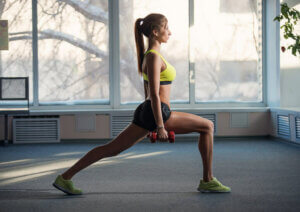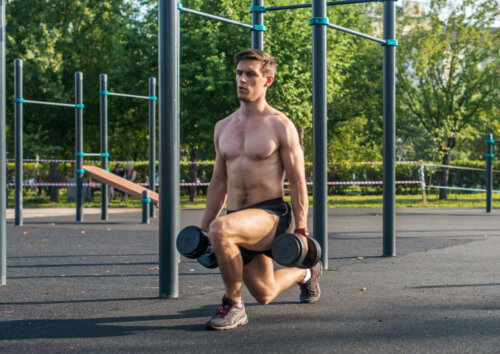Three Different Variations of Dumbbell Lunges

Working and strengthening the lower extremities on a regular basis is extremely important. For this reason, it’s vital that you add specific exercises to your routine. That being said, dumbbell lunges are a good alternative to work the legs and keep them in good condition.
It’s necessary to master the technique to properly carry out this exercise. Now, bear in mind that it’s pretty much impossible to achieve this process overnight, much less when adding the external weight. Therefore, you must do lunges first without a dumbbell.
Have you ever done dumbbell lunges? In this article, we’ll be showing you some of its variables so that you can put it into practice. Keep reading!
Things to bear in mind before doing dumbbell lunges
Dumbbell lunges are the primary alternative to conventional lunges. These are made with extra weight in order to raise the difficulty in their execution. In order to prevent any sort of injury or ailment in your body, we recommend you do them after mastering the technique of common lunges.
To perform this exercise, you must have two dumbbells of the same weight, one for each hand, which must have a neutral grip. Every person is different so you must choose dumbbells that are easy for you to lift.
Three variables of this lower body exercise
Lunges with or without dumbbells have the same starting position. First off, you must be standing, fully erect. Secondly, rest your hands on the respective side of the hips and keep your feet shoulder-width apart.
From there, a contraction of the core area should be done, especially the abdomen and pelvic floor. Once you’re in that position, you can move on to performing the lunges.
Common dumbbell lunges
Based on the starting position described above, now take a step forward with your right foot. Then flex your leg (forming a 90-degree angle) and your hip, and make the opposite knee to touch the floor gently.
The leg opposite to that of the lunge must touch the floor with the knee as well as a do a flexion, keeping the hip in its starting position.
Once you’re done with that, go back to the starting position and put the other leg forward to repeat the movement. Do this as many times as you want, depending on your workout regimen.

Dumbbell forward lunge
In this variant, the lunges are made in the same way as previously described. However, to perform the movement, you must follow the leg that takes the step forward.
In this way, you’ll take the step forward with the right leg, making the full movement of the lunge accompanied by a 2-4 second pause. The return to the starting position is done by this same leg, which forces the body to move forward.
Then, you perform the same motion with the left leg forward so that the movement is asymmetrical. Repeat this until you complete the desired distance. In regards to the dumbbell, we advise you to keep them at the sides of the hips while the displacement occurs.
Lunge jumps
These are probably the most complicated lunges due to the effort you must make in order to perform them correctly. In addition, they aren’t recommended for people with joint problems or obesity. However, they’re suitable for people who have a good command of the technique.
The starting position is different from the ones of the previous exercises. In this case, you must keep your legs apart as if you were already executing a common lunge. From there, perform the lunge gesture to gain momentum and then jump.
During the jump, the right leg (which is forward) goes back and the left goes forward. Basically, you execute this exercise with both limbs, and the exchange occurs between each jump.
There’s something important to bear in mind here. If you want to carry out lunge jumps, make sure your dumbbells aren’t very heavy. This allows the movement of the arms to accompany the jump.

Exercise with precautions
Despite being a relatively easy exercise, dumbbell lunges are quite complex due to the technique they demand. This workout must be performed in the best possible way in order to avoid knee, ankles, or vertebrae injuries. As usual, we recommend you have supervision from a physical activity professional.
Before doing any of the exercises we mentioned, we advise you to visit your family doctor to clarify whether or not there are any contraindications. Once you have professional approval, feel free to work your entire body to maintain good health.
Working and strengthening the lower extremities on a regular basis is extremely important. For this reason, it’s vital that you add specific exercises to your routine. That being said, dumbbell lunges are a good alternative to work the legs and keep them in good condition.
It’s necessary to master the technique to properly carry out this exercise. Now, bear in mind that it’s pretty much impossible to achieve this process overnight, much less when adding the external weight. Therefore, you must do lunges first without a dumbbell.
Have you ever done dumbbell lunges? In this article, we’ll be showing you some of its variables so that you can put it into practice. Keep reading!
Things to bear in mind before doing dumbbell lunges
Dumbbell lunges are the primary alternative to conventional lunges. These are made with extra weight in order to raise the difficulty in their execution. In order to prevent any sort of injury or ailment in your body, we recommend you do them after mastering the technique of common lunges.
To perform this exercise, you must have two dumbbells of the same weight, one for each hand, which must have a neutral grip. Every person is different so you must choose dumbbells that are easy for you to lift.
Three variables of this lower body exercise
Lunges with or without dumbbells have the same starting position. First off, you must be standing, fully erect. Secondly, rest your hands on the respective side of the hips and keep your feet shoulder-width apart.
From there, a contraction of the core area should be done, especially the abdomen and pelvic floor. Once you’re in that position, you can move on to performing the lunges.
Common dumbbell lunges
Based on the starting position described above, now take a step forward with your right foot. Then flex your leg (forming a 90-degree angle) and your hip, and make the opposite knee to touch the floor gently.
The leg opposite to that of the lunge must touch the floor with the knee as well as a do a flexion, keeping the hip in its starting position.
Once you’re done with that, go back to the starting position and put the other leg forward to repeat the movement. Do this as many times as you want, depending on your workout regimen.

Dumbbell forward lunge
In this variant, the lunges are made in the same way as previously described. However, to perform the movement, you must follow the leg that takes the step forward.
In this way, you’ll take the step forward with the right leg, making the full movement of the lunge accompanied by a 2-4 second pause. The return to the starting position is done by this same leg, which forces the body to move forward.
Then, you perform the same motion with the left leg forward so that the movement is asymmetrical. Repeat this until you complete the desired distance. In regards to the dumbbell, we advise you to keep them at the sides of the hips while the displacement occurs.
Lunge jumps
These are probably the most complicated lunges due to the effort you must make in order to perform them correctly. In addition, they aren’t recommended for people with joint problems or obesity. However, they’re suitable for people who have a good command of the technique.
The starting position is different from the ones of the previous exercises. In this case, you must keep your legs apart as if you were already executing a common lunge. From there, perform the lunge gesture to gain momentum and then jump.
During the jump, the right leg (which is forward) goes back and the left goes forward. Basically, you execute this exercise with both limbs, and the exchange occurs between each jump.
There’s something important to bear in mind here. If you want to carry out lunge jumps, make sure your dumbbells aren’t very heavy. This allows the movement of the arms to accompany the jump.

Exercise with precautions
Despite being a relatively easy exercise, dumbbell lunges are quite complex due to the technique they demand. This workout must be performed in the best possible way in order to avoid knee, ankles, or vertebrae injuries. As usual, we recommend you have supervision from a physical activity professional.
Before doing any of the exercises we mentioned, we advise you to visit your family doctor to clarify whether or not there are any contraindications. Once you have professional approval, feel free to work your entire body to maintain good health.
All cited sources were thoroughly reviewed by our team to ensure their quality, reliability, currency, and validity. The bibliography of this article was considered reliable and of academic or scientific accuracy.
- Navandar, A. (2008). Activación Muscular De Cuádriceps E Isquiotibiales En Distintos Ejercicios. VIII Congreso Internacional de La Asociación Española de Ciencias Del Deporte.
- Aguilera-Castells, J., Buscà, B., Peña, J., Fort-Vanmeerhaeghe, A., Solana-Tramunt, M., & Morales, J. (2019). Suspended lunge exercise: Assessment of forces in different positions and paces. Aloma.
- Dufour, M. (2012). Anatomía del miembro inferior. EMC – Podología. https://doi.org/10.1016/s1762-827x(12)61929-4
This text is provided for informational purposes only and does not replace consultation with a professional. If in doubt, consult your specialist.








